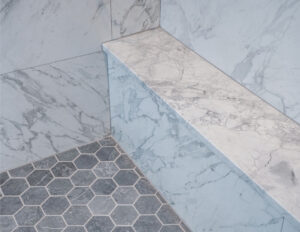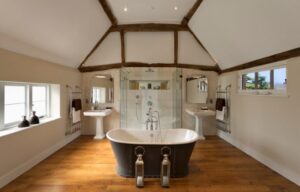Alright, let’s get this show on the road.
Contents
- 1 How To Design A Mudroom That Handles Winter Messes (Without Losing Your Mind)
- 2 Laying the Groundwork: The Mudroom Must-Haves
- 3 The Holy Trinity of Storage: Seating, Cubbies, and Hooks
- 4 Choosing the Right Flooring: Your Unsung Hero
- 5 Taking It to the Next Level: Smart Upgrades for a Luxury Mudroom
- 6 The Game-Changer: A Dedicated Drying Zone
- 7 Taming the Tech and Pet Chaos
- 8 Planning Your Mudroom Project: Where Does It Go?
- 9 Finding the Space: It Might Be Closer Than You Think
- 10 Making It Happen: Working With the Right Team
- 11 What to Look For in a Home Renovation Contractor
- 12 Your Mudroom Questions, Answered
- 13 A Final Thought: Your Winter Sanity Saver Awaits
How To Design A Mudroom That Handles Winter Messes (Without Losing Your Mind)
We’ve all been there. It’s a classic Colorado winter day—beautiful, snowy, and bitingly cold. The family bursts through the door, trailing a small avalanche of slush, grit, and discarded gloves. Suddenly, your pristine entryway looks like a ski resort lost and found. Sound familiar? We feel your pain. That daily battle against the elements is exactly why we believe the mudroom isn’t just another room; it’s your home’s first line of defense.
Think of it as mission control for the great indoors. A well-designed mudroom doesn’t just contain the chaos; it restores order and sanity. And as a general contractor here in Denver, we’ve seen our fair share of mudrooms, from afterthoughts to absolute masterpieces. So, grab a cup of coffee, and let’s talk about how we can design a space that actually works for your life, not against it.
Laying the Groundwork: The Mudroom Must-Haves
Before we get lost in dreams of custom built-ins and heated floors (we’ll get there, promise), we need to talk fundamentals. Any successful home remodeling project starts with a solid plan. What makes a mudroom truly functional? Let’s break it down.
The Holy Trinity of Storage: Seating, Cubbies, and Hooks
Every mudroom needs a place to park yourself, a place to park your stuff, and a place to hang your coat. It seems simple, but the devil is in the details.
- A Sturdy Bench: This is your landing pad. It needs to be tough enough to withstand wet snow pants and boots being dragged across it. We often recommend a bench with a lift-up lid for hidden storage—perfect for stashing seasonal items or bulk pet food. It’s a simple feature that adds a huge amount of functionality.
- Individual Cubbies: If you have a family, assigning each person their own cubby is a game-changer. No more arguing over whose mittens are whose. It personalizes the space and makes cleanup a breeze. For a truly custom remodel, we can design these to fit specific needs, like deeper slots for hockey bags or taller spaces for adult coats.
- Ample Hanging Rods & Hooks: Never underestimate the power of a good hook. We like to install a mix of fixed hooks for everyday items and a section of adjustable rod for longer coats. This flexibility is key for adapting to our wildly fluctuating seasons.
Choosing the Right Flooring: Your Unsung Hero
The floor of your mudroom is the true MVP. It takes the brunt of the abuse, so choosing the right material is non-negotiable. We need something durable, water-resistant, and easy to clean. Porcelain tile that looks like wood is a perennial favorite for a reason. It’s incredibly tough and handles water and salt like a champ. Luxury vinyl plank is another fantastic option, offering warmth underfoot and serious durability.
But the floor itself is only part of the equation. You absolutely need great mats. We recommend a two-mat system:
- A coarse, abrasive mat on the outside of the door to scrape off the bulk of the snow and debris.
- A highly absorbent, washable mat on the inside to catch any remaining water.
This one-two punch will save your floors every single time. Trust us on this.
Taking It to the Next Level: Smart Upgrades for a Luxury Mudroom
Okay, basics are covered. Now for the fun part. What if your mudroom could do more than just contain messes? What if it could actively make your life easier? This is where those luxury home renovations really shine.
The Game-Changer: A Dedicated Drying Zone
Wet gear is the enemy. Let’s give it a dedicated surrender zone. This could be a section of pegboard with hooks for hanging wet gloves and hats to air dry, or a rack specifically designed for bulky snow boots. For the ultimate solution, consider installing a low-output radiant heating system under the tile in the boot area. It gently warms the floor, evaporating moisture overnight. Is it a necessity? No. Is it a glorious luxury that will make you feel like a winter-conquering genius? Absolutely.
Taming the Tech and Pet Chaos
Our mudrooms often become dumping grounds for more than just outerwear. Why not plan for that?
- Pet Stations: If you have furry family members, incorporate a built-in niche for their food and water bowls. A small cabinet for storing leashes, treats, and towels keeps everything tidy. A pet-washing station is the pinnacle of mudroom luxury, especially after a muddy spring hike.
- Charging Drawers: We all have devices. A drawer with built-in USB outlets allows you to charge phones and tablets out of sight, reducing counter clutter. It’s a small detail with a huge impact on organization.
Planning Your Mudroom Project: Where Does It Go?
Not every home has a dedicated space labeled “mudroom” on the original floor plan. That’s where a bit of creative thinking—and the right home renovation contractor—comes in. You’d be surprised how many underutilized spaces can be transformed.
Finding the Space: It Might Be Closer Than You Think
When homeowners ask us about adding a mudroom, the first thing we do is look at the existing layout. You might not need a whole house remodeling project to get the mudroom of your dreams. Here are a few common spots we often convert:
- The Side Entrance: This is the most classic location, often leading from the garage or a side yard.
- Garage Conversion: If you have extra space in your garage, walling off a section to create an interior-entry mudroom is a fantastic solution. It contains the mess before it even enters the main house.
- Back Hallway: A narrow, unused hallway can be the perfect candidate for some built-in benches and storage.
- Laundry Room Combo: Combining your laundry and mudroom functions is a highly efficient use of space. Wet clothes go directly from the person to the washer. It’s a logical win.
The key is to work with a remodeling company that can see the potential in your home’s existing footprint. For instance, at Verified Builders, we recently helped a family in Cherry Creek convert a wasted closet and a sliver of hallway into a stunning and highly functional mudroom. It’s all about smart design.
Making It Happen: Working With the Right Team
Designing the perfect mudroom is one thing; building it is another. This isn’t typically a DIY project if you’re looking for built-in, custom solutions. You need a professional. But how do you find the right general contractor for the job?
What to Look For in a Home Renovation Contractor
A quick search for “home remodeling near me” will give you dozens of options. But you don’t just want the nearest contractor; you want the best one for your project. Here’s what we recommend you look for:
- Specialization: Do they have experience with the type of project you’re planning? A bathroom renovation contractor might be brilliant, but a mudroom has different requirements. Look for a team experienced in creating functional living spaces.
- Portfolio & Reviews: Any reputable contractor will have a portfolio of their work. Look for projects similar in scale and style to what you want. And please, read the reviews! They offer invaluable insight into what it’s actually like to work with a company.
- Communication: From the first call, are they listening to your ideas? You want a partner, not just a hired hand. The best house remodelers see themselves as problem-solvers who bring your vision to life.
We might be a bit biased, but we believe that Verified Builders exemplifies this approach. Whether you’re considering a basement renovation to add a new mudroom or a patio remodeling project, our focus is always on clear communication, quality craftsmanship, and making the process as smooth as possible for you.
Your Mudroom Questions, Answered
Let’s tackle some of the most common questions we get about mudrooms.
1. What if I have very limited space?
No problem! Even a tiny nook can be optimized. Instead of a full bench, use a fold-down seat. Mount hooks vertically to maximize wall space. A shallow, wall-mounted shelf with bins can serve as mini-cubbies. The goal is to use every inch intelligently. A good home addition contractor can often find space you didn’t know you had, but often, a clever bathroom remodeling-sized project is all you need to carve out a functional drop-zone.
2. How much does a new mudroom typically cost?
This is the “how long is a piece of string?” question. Costs can range from a few thousand dollars for some simple built-ins in an existing space to $20,000+ for a full garage conversion or basement remodel with high-end finishes and electrical work. The best way to get an accurate idea is to have a basement remodel contractor or general contractor out for a consultation. At Verified Builders, we provide transparent quotes so you know exactly what to expect.
3. What’s the single best feature I can add?
IMO, it’s a deep sink or a utility tub. Being able to rinse off muddy boots or fill a mop bucket without trekking through the house is incredibly convenient. It’s a feature you’ll use constantly, especially here in Denver where our weather can be… adventurous.
A Final Thought: Your Winter Sanity Saver Awaits
A well-designed mudroom is more than just storage; it’s a lifestyle upgrade. It’s the difference between starting and ending your day in chaos versus calm. It’s about creating a home that works as hard as you do.
We’ve seen the transformation it brings to families firsthand. If you’re dreaming of a mudroom that can handle anything our Colorado winters throw at it, let’s talk. The team at Verified Builders is passionate about creating beautiful, functional spaces right here in Denver. Don’t just search for the closest contractor; find the right partner to bring your vision to life.


